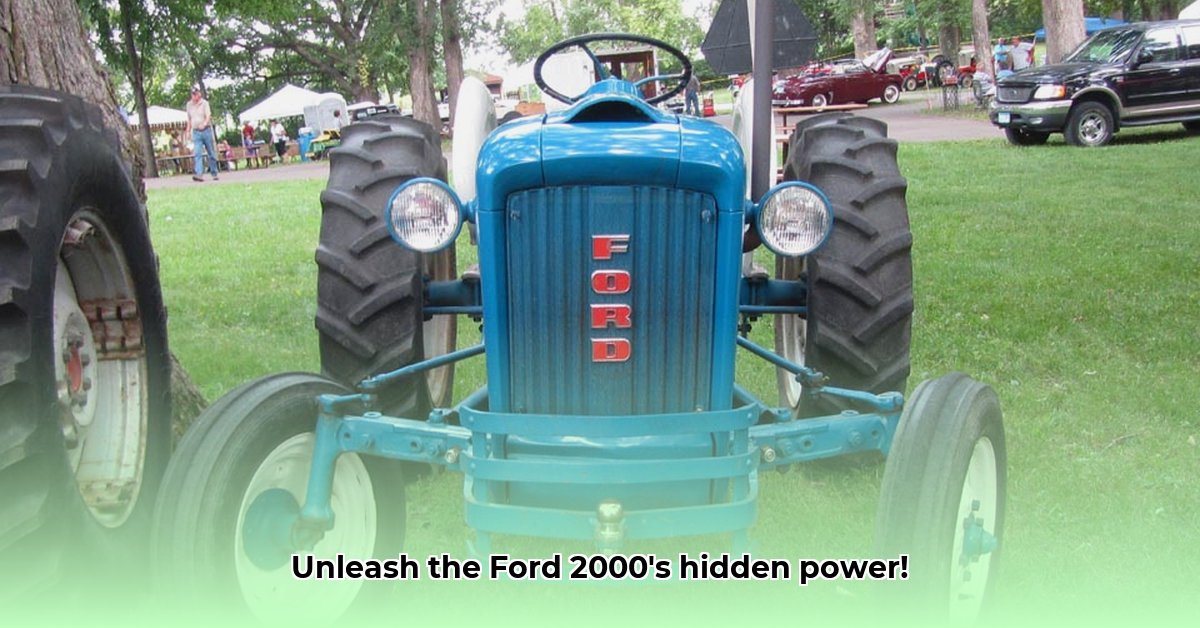
The Ford 2000 tractor—a mainstay of mid-20th-century agriculture—holds a unique place in farming history. But the seemingly simple designation belies a significant difference: two distinct generations, each with its own horsepower characteristics and design features. This guide will dissect the power output, design choices, and historical context of both the four-cylinder and three-cylinder versions of the Ford 2000. For more on Ford tractors, see this helpful page: Ford Tractor Problems.
Generation 1: The Four-Cylinder Ford 2000 (circa 1962-1964)
The first generation Ford 2000, launched in the early 1960s, represented a substantial advancement in farm technology. Employing a four-cylinder engine, it offered significant power compared to its predecessors. While Ford's advertised horsepower varied depending on the fuel type (gasoline or diesel), ranging approximately from 30 to 48 hp, real-world performance often varied considerably based on factors such as terrain and implement use. Many owners noted a discrepancy between the manufacturer's claims and on-the-ground results. This generation featured a straightforward transmission typical of the era and an open-center hydraulic system for implement lifting. Optional front-end loaders provided additional versatility. But its simpler mechanical design often meant less precise power delivery compared to later models.
Did you know that many accounts detail the robust nature of the four-cylinder engine, despite lower-than-advertised output in some situations? This speaks to the enduring reliability of the design. This generation was a workhorse—strong and dependable.
Generation 2: The Three-Cylinder Ford 2000 (circa 1965-1975)
By 1965, Ford introduced a redesigned Ford 2000, this time with a three-cylinder engine. This shift was largely driven by cost-reduction strategies. While maintaining a similar engine displacement (around 2.6 liters), the three-cylinder design changed power delivery and fuel economy. The advertised horsepower remained in a similar range to the previous generation, yet independent testing again suggests often lower real-world numbers. This three-cylinder model, however, offered improvements including a significant upgrade: the introduction of a live power take-off (PTO) which afforded more refined control over implements. This generation also featured numerous transmission options, offering farmers greater flexibility in matching the tractor's performance to the demands of various tasks.
The shift to a three-cylinder engine highlights the ongoing tension between cost optimization and performance in engineering.
Comparative Analysis: Four-Cylinder vs. Three-Cylinder
A direct comparison reveals key differences between these two generations. The three-cylinder model often shows a heavier build, suggesting an improvement in structural durability. While the exact power output remains subject to debate and varied testing conditions, the three-cylinder offered advantages in efficiency and some aspects of control.
| Feature | Generation 1 (4-Cylinder) | Generation 2 (3-Cylinder) |
|---|---|---|
| Engine Type | Four-cylinder | Three-cylinder |
| Engine Size (approx.) | 2.2L (gasoline) / 2.4L (diesel) | 2.6L (gasoline & diesel) |
| Claimed Horsepower | 30-48 hp (variable based on fuel type) | Similar range (often lower in practice) |
| Transmission | Simpler design, fewer gear options | More gear options, enhanced speed ranges |
| PTO | Standard | Live PTO |
| Hydraulic System | Open-center | Open-center (potential improvements) |
| Build Quality | Generally Lighter | Generally Heavier |
The transition to a three-cylinder engine in the second generation underscores the crucial design trade-offs involved in agricultural machinery. While it may not have always presented a clear increase in horsepower, the improvements in fuel economy, live PTO, and potentially the hydraulic system, balanced against the cost savings, made the three-cylinder a compelling option for many farmers.
Conclusion: A Legacy of Innovation and Practicality
The Ford 2000 tractor, with its two distinct generations, serves as a compelling case study in agricultural engineering. It demonstrates the challenges of balancing power needs, technological advancements (like the live PTO), and economic realities. Understanding the specific characteristics of each generation, including their claimed and real-world horsepower, is vital for collectors, historians, and anyone working with these classic machines. Further research into the individual model variations within each generation is highly recommended for those needing precise performance data. The Ford 2000's legacy continues not just in its operational impact, but also as a testament to the evolution of farm technology.